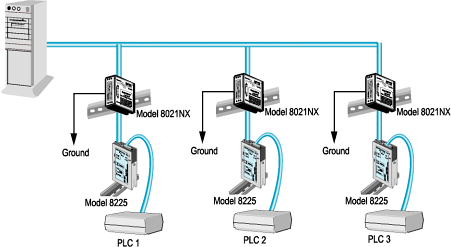
Lightning has long fascinated the technical community. Ben Franklin
studied lightning's electrical nature over 2 centuries ago and Charles
P. Steinmetz generated artificial lightning in his General Electric
laboratory in the 1920's. Anyone concerned with premises data
communications needs to worry about lightning. Few worry enough!
High voltage transients caused by lightning and other electrical
disturbances have the easy ability to destroy semiconductor junctions
and thus cause equipment failure. A lightning strike in the vicinity of
data lines can cause induced ground currents that can also do serious
damage.
However, coming right down to it, a lot can be done as far as protection
is concerned. In particular, typical leading edge wave-fronts of a
lightning strike rise at the rate of 1,000 Volts per microsecond.
Adequate protection from this particular lightning threat can be
provided by the Model 8021NX Lightning Sponge.
This unit is intended to provide protection to data equipment having 2
wire RS-485 interfaces or actually any RS-485 network. It provides
protection for data transmission speeds up to 20 MBPS. This unit
provides common-mode (line-to-ground) surge protection and differential
mode (line-to-line) protection for balanced networks. It has a clamp
voltage of 7.5 V.
The Model 8021NX also has a DIN Rail mounting. DIN Rail is a cabling
system that was developed for factory automation and is now available
for computer room use. The system is very simple and straightforward. It
uses a steel channel called a DIN Rail. The rail has slotted holes for
mounting. The Rail is normally mounted in a horizontal position. DIN
Rail products are then placed in the Rail by snapping them into place
after which the wiring is completed. DIN Rail mounting helps organize
the computer room and prevents 'messy cabling' in the factory
environment.
It would be a good idea to have a Model 8021NX installed on each end of
the transmission line for RS-485 data devices found in the premises data
communication environment.
The illustration above shows the Model 8021NX in a typical application.
The unit is placed just before the Controller on the extreme left but it
could also be elsewhere in this network. Space forces us to make the
illustration simple. . Notice the designations of 'Earth Ground.' This
unit and other similar lightning sponges operate by directing lightning
induced currents to 'Earth Ground.' It is important that the Model 22 be
grounded properly. This should be done with a wire that is, at least, 12
AWG. Connection to cold water pipes probably provides the best ground.
However, make sure that they are metal not plastic. Connection to a
plastic pipe doesn't help. Also beware of connecting to a ground stud in
a wall which, itself, is not connected to Earth Ground.
|


